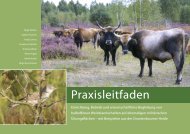TAGUNGSBAND CONFERENCE PROCEEDINGS - Offenlandinfo
TAGUNGSBAND CONFERENCE PROCEEDINGS - Offenlandinfo
TAGUNGSBAND CONFERENCE PROCEEDINGS - Offenlandinfo
Erfolgreiche ePaper selbst erstellen
Machen Sie aus Ihren PDF Publikationen ein blätterbares Flipbook mit unserer einzigartigen Google optimierten e-Paper Software.
Extensive Dachbegrünung mit Substraten<br />
aus regionalen Bodenmaterialien<br />
und Pflanzen pannonischer Trockenrasen<br />
Alexandra Köninger<br />
HBLFA für Gartenbau Schönbrunn, Garten- und Landschaftsgestaltung,<br />
Wien, Österreich<br />
Das LFZ Schönbrunn, Abt. Garten- und Landschaftsgestaltung,<br />
führt seit Herbst 2008 ein wissenschaftliches Projekt<br />
durch, dessen Ziel es ist, eine naturnahe Alternative zur<br />
herkömmlichen Begrünung von Extensivdächern zu entwickeln.<br />
Dabei wurde ein Dachgartensubstrat auf der Basis<br />
von lokalen Bodenmaterialien entwickelt sowie ein Set von<br />
47 Pflanzen der pannonischen Trocken- und Halbtrockenrasen<br />
ausgewählt. Die Pflanzen und das Substrat werden auf<br />
ihre Eignung für die extensive Dachbegrünung überprüft.<br />
32<br />
Stellwand-Nr.<br />
Poster Panel No.<br />
17<br />
Contribution to the restoration of<br />
dwarf-shrub heathlands on dump sites<br />
in the Lusatian Lignite District<br />
(Germany)<br />
Ingmar Landeck 1 , Doris Wüstenhagen 2<br />
1 Research Institute for Post-Mining Landscapes e.V. (FIB),<br />
Finsterwalde, Deutschland<br />
2 Vattenfall Europe Mining AG, Cottbus, Deutschland<br />
Former landscape of the open-cast mine Nochten was one<br />
of the classic heathland regions in East Germany. For this<br />
reason, it is necessary to search for possibilities to re-establish<br />
initials of heaths restorating the post-mining landscape.<br />
In order to provide the necessary database, site parameters<br />
of 20 spontaneous settlements of Calluna vulgaris on<br />
several dump sites (Brandenburg-S and Saxony-NO) have<br />
been analyzed. Test sites were located north of the village<br />
Nochten (Free State of Saxony, 14° 28‘48‘‘- 14° 40‘07‘‘E and<br />
51° 28‘53‘‘- 51° 25‘11‘‘N).<br />
As parts of the experiment, the use of regional seed (capsules)<br />
and mowing material, sods from surrounding heaths as<br />
well as young plants of heather were tested on a plane and<br />
an inclined site each. Three experimental blocks (sparse<br />
protective sowing with Festuca brevipila, birch shelter planting,<br />
control variant) were considered. The field trail started<br />
in autumn of 1999 with repetitions of all experimental plots<br />
established in following spring. All plots were 100 m² in size<br />
and surrounded by walls (50 cm in height) made of birch<br />
twigs. Heather plants were 3 to 5 years old and classified<br />
into four size classes. For seeding whole capsules were<br />
used in a density of 1.5 g*m-2 . A final control investigation<br />
was carried out in 2008, eight years after starting the<br />
experiment.<br />
After evaluation of the field trial, following recommendations<br />
for the initiation of heathlands are given. Sites with<br />
low base saturation (below 40 %), rich in fine-sand fraction<br />
(> 20%), low pH values (optimum 3.5 to 5.0), phosphorus<br />
and potassium deficiency, medium to wide C/N ratios and<br />
with increased silt and clay content are most suitable.<br />
Planting of heather seedlings is predominantly unproblematic,<br />
but is should be realized only in autumn using<br />
middle-sized 2 to 4 years old container plants. After 3 years<br />
the survival rate is usually 50-75 %. Due to a rapid development<br />
of inflorescences a 2nd Generation of plants appear 3<br />
to 5 years after planting. Sowing of heather is only successful<br />
on plane sites after establishing a sparse protective vegetation<br />
cover or in the presence of spontaneous pioneer<br />
vegetation. Inhibitory effects on the developing heath are<br />
not observed. Following a critical establishing phase a well<br />
developed heath cover is established within five years after<br />
sowing. Using sods, however, bear the risk of displacement<br />
of stolons of Calamagrostis epigejos, which subsequently<br />
benefits from nitrogene output of the shelter walls.<br />
Stellwand-Nr.<br />
Poster Panel No.<br />
18




